Cycle Touring in The Netherlands: a five day circular Dutch Tour, August 2013
Having ridden the iconic C2C a couple of years earlier, Helen and I, along with friends Pete and Sharon, were looking for something rather more exotic as a cycling project for the summer of 2013. I had come across an excellent publication the previous winter, Cycling in The Netherlands by Eric van der Horst. This is a detailed description of a basically circular tour of the country, with options, and provides excellent route planning, along with distances as well as an overview of each section of the route. It is pitched very firmly at the international cyclist and proved to be perfect for our purpose.
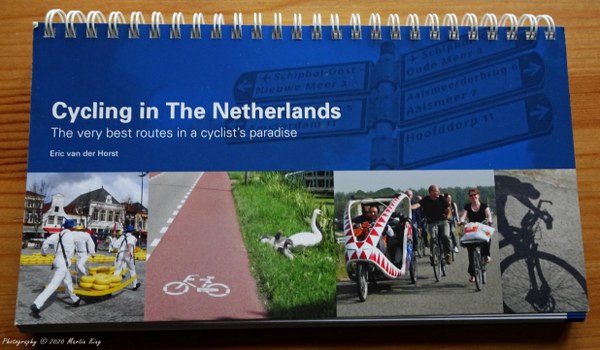 There can be very few cyclists who are unaware of The Netherlands' cycling heritage which quite rightly is revered around the world as being an ideal cycling model. To the uninitiated the Netherlands have created a wonderful network of some 40,000 kilometres of essentially traffic-free cycling routes, mostly on flat terrain. With a broad range of cycling-minded traffic rules the country offers a safe environment for cyclists of all ability, unlike many other countries including our own here in the UK. In The Netherlands it seems everyone cycles, be it commuters, families, shoppers or the casual cyclist. Having heard so much about it we were keen to taste the Dutch cycling experience for ourselves.
There can be very few cyclists who are unaware of The Netherlands' cycling heritage which quite rightly is revered around the world as being an ideal cycling model. To the uninitiated the Netherlands have created a wonderful network of some 40,000 kilometres of essentially traffic-free cycling routes, mostly on flat terrain. With a broad range of cycling-minded traffic rules the country offers a safe environment for cyclists of all ability, unlike many other countries including our own here in the UK. In The Netherlands it seems everyone cycles, be it commuters, families, shoppers or the casual cyclist. Having heard so much about it we were keen to taste the Dutch cycling experience for ourselves.
We had learned a few lessons after our C2C experience two years previously and our aim was to travel light. My mantra is to take a credit card and a toothbrush, and whilst we did in the end opt for a few luxury items (such as spare cycling clothing) we were able to pack most of what we needed in a bar bag and a small backpack each (I know, people say you shouldn't ride with a rucksack but we were still young and didn't know any better!). I confess the appeal of panniers has failed to move me, I always feel that whatever bags you attach to the bike you will fill them, quite often with things that you really don't need. It's controversial I know, but travelling light works for us.
The great thing about a circular tour is that you can essentially hop on and off at any point along the route. After much planning we opted for a five day tour in August 2013, starting and finishing at the international ferry terminal at Europoort in Rotterdam. From the UK Rotterdam is easy to get to with daily overnight ferry sailings from Hull. As befits a ferry service into Holland cyclists are generally welcomed and travelling with a bike is at the same cost as foot passengers, all very civilised. The advantage of this is that we would wake up in port after a good night's sleep ready for a full day's cycling. From Europoort we would have a short warm-up ride and a ferry crossing to join the route at Hoek van Holland. It all looked so easy. The five days would introduce us to well known Dutch towns including Den Haag, Haarlem, Amsterdam, Utrecht, Gouda and Delft as well as chances to see windmills, canals and bicycles galore. I spent an evening calculating daily distances and finding suitable overnight accommodation which proved so easy to book online. By early in the spring of 2013 we were all set. Bring it on!
Day 1: Europoort, Hoek van Holland and Nordvijk (69km, 250m of ascent)
Waking up to the sound of a ferry horn as we entered the massive Europoort was a tad surreal. Europoort is part of the Port of Rotterdam, Europe's largest seaport, and one of the busiest in the world. It seemed to take forever to navigate through the masses of cranes and container bays, passing numerous large ships before we finally docked on the south side of Nieuwe Waterweg, the waterway on around which the Port is situated. I have to say that sleeping on board the North Sea ferries is never easy, but we felt ready for the day ahead as we rode down the slipway and into the Netherlands. Our adventure was about to begin.
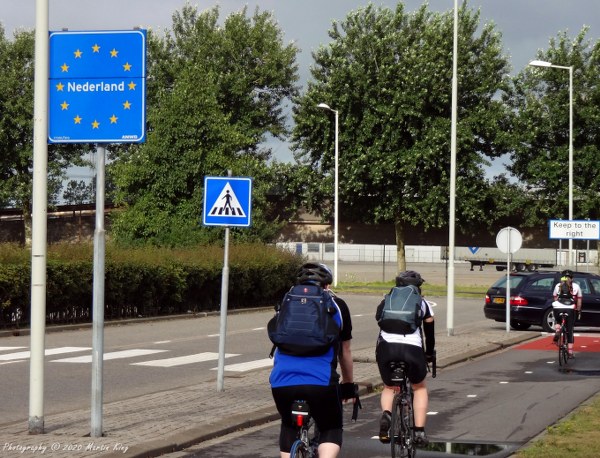 The first leg of our journey was all about navigating a way to Hoek van Holland, via cycleways and a ferry to get across the Nieuwe Waterweg. This meant some 20km on a circuitous route round the various quays and water inlets to the ferry landing at Maasvlakte. We immediately found ourselves on a network of two-way cyclepaths which shadow the road network round the Port, but keep cyclists separate from other road traffic. When it came to crossing a side road we were pleasantly surprised to find that the cycle paths invariably had right of way, something which took us a day or so to get used to based on what we were used to back in the UK. It really was surreal to watch cars exiting from major roads come to a halt to let us cross. We suddenly felt like traffic royalty. Whilst this stretch was definitely not the most scenic of our tour, it served as a perfect introduction to what we could expect in the days ahead.
The first leg of our journey was all about navigating a way to Hoek van Holland, via cycleways and a ferry to get across the Nieuwe Waterweg. This meant some 20km on a circuitous route round the various quays and water inlets to the ferry landing at Maasvlakte. We immediately found ourselves on a network of two-way cyclepaths which shadow the road network round the Port, but keep cyclists separate from other road traffic. When it came to crossing a side road we were pleasantly surprised to find that the cycle paths invariably had right of way, something which took us a day or so to get used to based on what we were used to back in the UK. It really was surreal to watch cars exiting from major roads come to a halt to let us cross. We suddenly felt like traffic royalty. Whilst this stretch was definitely not the most scenic of our tour, it served as a perfect introduction to what we could expect in the days ahead.
We had a short wait at the ferry landing before boarding the fast catamaran ferry for the short crossing to Hoek van Holland, a small town on the North Sea coast right at the mouth of the Nieuwe Waterweg, and the start of our tour proper. One of the wonderful things we found across the whole country is the integration of different transport types which makes getting around so much easier. Taking a bike on a ferry is so commonplace that it seems that everybody is doing it. After a short wait we were on our boat and speeding across the waterway, dodging large container ships and ocean going ferries with ease. Disembarking at Hoek van Holland we quickly found the cycle route thanks to good maps and the excellent signage which typifies the cycling network across the country. What followed for much of the rest of the day was a cycling delight – good waymarks and well surfaced paths, wide enough for two way traffic and with clear visibility. From Hoek van Holland this traffic free cycling highway took us north through a network of sand dunes, passing villages such as Monster, Kijkduin and Duindorp. Having been on the go since breakfast we were all now ready for something to eat and in Kijkduin we found a bar where we indulged in crepes and a cheeky beer to keep us going.
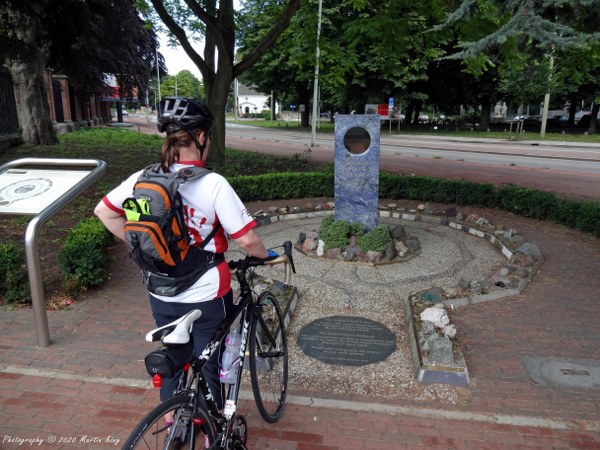 Once on the move again we soon arrived in what was our first significant town, Den Haag. I am ashamed to say my language skills as far as Dutch is concerned are more or less non-existent, but here in the Netherlands English is pretty much a second language. In any case, the signage makes it all very easy and most information boards are in English. Den Haag is only Holland's third largest city but it is both the administrative and royal capital and, in common with many Dutch towns and cities, has its fair share of grandiose and imposing architectural buildings. We rode past the Peace Palace which is home to the International Court of Justice. Here we came across the World Peace Flame, which has been burning since 1999 back in Wales, but Holland has one too, though more recent in 2004. A total of 196 pebbles and rocks (we didn't count them) are arranged round the flame, representing 196 countries across the world. By now, with 44 kilometres ticked off we all agreed that refreshment was required and we settled into a street café in the heart of the city for a well earned coffee break as we watched the bustling world go about its business. Such is the lot of the English cycle tourist!
Once on the move again we soon arrived in what was our first significant town, Den Haag. I am ashamed to say my language skills as far as Dutch is concerned are more or less non-existent, but here in the Netherlands English is pretty much a second language. In any case, the signage makes it all very easy and most information boards are in English. Den Haag is only Holland's third largest city but it is both the administrative and royal capital and, in common with many Dutch towns and cities, has its fair share of grandiose and imposing architectural buildings. We rode past the Peace Palace which is home to the International Court of Justice. Here we came across the World Peace Flame, which has been burning since 1999 back in Wales, but Holland has one too, though more recent in 2004. A total of 196 pebbles and rocks (we didn't count them) are arranged round the flame, representing 196 countries across the world. By now, with 44 kilometres ticked off we all agreed that refreshment was required and we settled into a street café in the heart of the city for a well earned coffee break as we watched the bustling world go about its business. Such is the lot of the English cycle tourist!
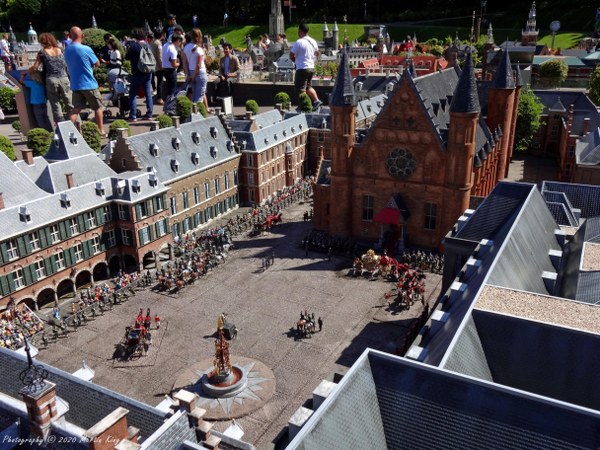 Den Haag is also home to Madurodam. For those who haven't visited, Madurodam has to be one of the best model villages anywhere. In practice it is so much more, it is more a representation of Holland in miniature and the park covers a vast area. Our route took us right past the front gate and it seemed rude not to pay a visit. So we did. Parking the bikes was easy (a feature everywhere in Holland) and we joined the hundreds of visitors wandering round the exhibits. Dating from 1952 Madurodam is essentially a collection of famous Dutch sights, buildings and landmarks on a 1:25 scale. It would have been easy to spend several hours here had we had the time. The models are really good with much attention to detail, but laced with some humour as well. and in a short time we had a real feel to pretty much everything we could expect to see over the next few days.
Den Haag is also home to Madurodam. For those who haven't visited, Madurodam has to be one of the best model villages anywhere. In practice it is so much more, it is more a representation of Holland in miniature and the park covers a vast area. Our route took us right past the front gate and it seemed rude not to pay a visit. So we did. Parking the bikes was easy (a feature everywhere in Holland) and we joined the hundreds of visitors wandering round the exhibits. Dating from 1952 Madurodam is essentially a collection of famous Dutch sights, buildings and landmarks on a 1:25 scale. It would have been easy to spend several hours here had we had the time. The models are really good with much attention to detail, but laced with some humour as well. and in a short time we had a real feel to pretty much everything we could expect to see over the next few days.
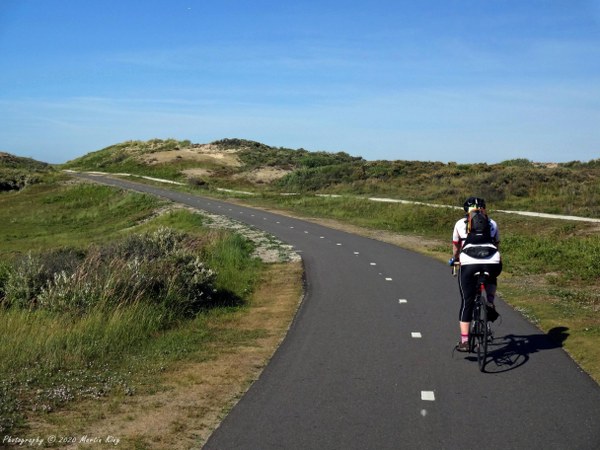 Back on our bikes we continued along our cycle path, heading out of Den Haag toward Water Tower, imaginatively named because, basically, it is a water tower! We were now on what is undoubtedly a fine stretch of the Dutch coastal cycle way, and which heads all the way north along the sandy coast to Haarlem. The dunes here are vast, as wide as 6 kilometres in places, and our cycle highway plotted a winding undulating route through the very heart of this sandy wilderness. Much of it is also nature reserve with a host of bird species here. Along the way there are also a number of seaside towns where the Dutch flock to spend time by the sea. These all have wonderful sounding names such as Wassenaarse Slag and Katwijk. By now I was falling in love with the language. Our day was nearly done and some 4 kilometres on from Katwijk we rode into the little town of Nordvijk, where we sought out our overnight accommodation, the Hotel De Ossewa. It had been a delightful introduction to our Dutch cycling experience, a gentle day to ease us into our holiday with fine weather and the added bonus of a tailwind for much of the day – and we still had another 4 days to come.
Back on our bikes we continued along our cycle path, heading out of Den Haag toward Water Tower, imaginatively named because, basically, it is a water tower! We were now on what is undoubtedly a fine stretch of the Dutch coastal cycle way, and which heads all the way north along the sandy coast to Haarlem. The dunes here are vast, as wide as 6 kilometres in places, and our cycle highway plotted a winding undulating route through the very heart of this sandy wilderness. Much of it is also nature reserve with a host of bird species here. Along the way there are also a number of seaside towns where the Dutch flock to spend time by the sea. These all have wonderful sounding names such as Wassenaarse Slag and Katwijk. By now I was falling in love with the language. Our day was nearly done and some 4 kilometres on from Katwijk we rode into the little town of Nordvijk, where we sought out our overnight accommodation, the Hotel De Ossewa. It had been a delightful introduction to our Dutch cycling experience, a gentle day to ease us into our holiday with fine weather and the added bonus of a tailwind for much of the day – and we still had another 4 days to come.
Day 2: Nordvijk to Amsterdam (83km, 225m of ascent)
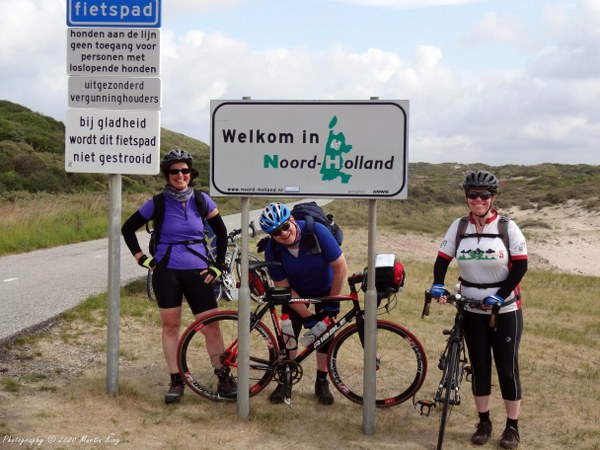 Our second day dawned bright and sunny, blue skies greeting us as we threw back the curtains. The forecast was for rain later but for now it was a proper summer holiday by the seaside! We rode down through the centre of town to rejoin our cycle highway down by the beach next to a large and imposing bronze statue of Queen Wilhelmina. The friendly tailwind we had enjoyed the previous day was still blowing and we soon found ourselves speeding northwards through the sand dunes along what is the most remote section of the coastal cycle path. Halfway to Zandvoort we crossed the provincial boundary from Zuid Holland into Noord Holland, and we realised that the Netherlands is much more than simply Holland, there being a total of 12 provinces. After an enjoyable and relaxing forty minutes we reached the town of Zandvoort and stopped in the Grand Café Hotel where we all agreed that a coffee would go down well. Zandvoort is pleasant enough but lacked soul and was really just a simple seaside resort at best. Still, it was nice to relax in the morning sun and watch the world go by.
Our second day dawned bright and sunny, blue skies greeting us as we threw back the curtains. The forecast was for rain later but for now it was a proper summer holiday by the seaside! We rode down through the centre of town to rejoin our cycle highway down by the beach next to a large and imposing bronze statue of Queen Wilhelmina. The friendly tailwind we had enjoyed the previous day was still blowing and we soon found ourselves speeding northwards through the sand dunes along what is the most remote section of the coastal cycle path. Halfway to Zandvoort we crossed the provincial boundary from Zuid Holland into Noord Holland, and we realised that the Netherlands is much more than simply Holland, there being a total of 12 provinces. After an enjoyable and relaxing forty minutes we reached the town of Zandvoort and stopped in the Grand Café Hotel where we all agreed that a coffee would go down well. Zandvoort is pleasant enough but lacked soul and was really just a simple seaside resort at best. Still, it was nice to relax in the morning sun and watch the world go by.
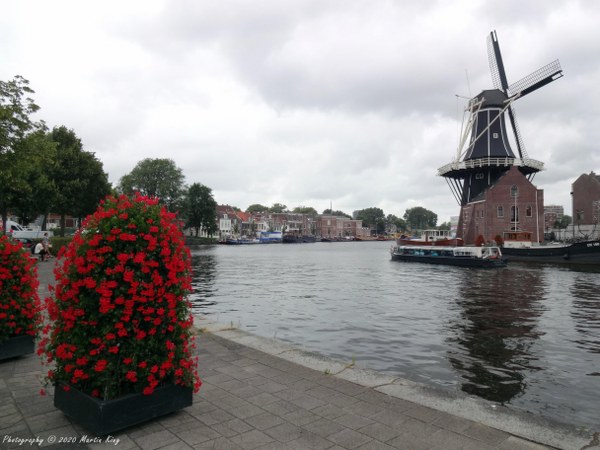 Shortly after Zandvoort our route at last changed direction to head inland, east through Overveen to the city of Haarlem. We bade our tailwind farewell and, as if in cahoots, the skies clouded over. Still, the day was pleasant enough and we rode into Haarlem along one of the medieval canals which provide the lifeblood of the city. Haarlem is a splendid old town with lots of Gothic architecture to delight the eye and keep the camera busy. It has a long and illustrious history, and enjoyed a boom period during the Dutch Golden Age. Narrow streets were filled with pedestrians and cyclists alike and the whole place was buzzing. We found the De Kroon Café-Restaurant, a splendid old bulding in the centre of town and settled down at a table on the café front where we ordered a fine lunch and treated ourselves to a cheeky Leffe beer. This was what cycle touring holidays were all about.
Shortly after Zandvoort our route at last changed direction to head inland, east through Overveen to the city of Haarlem. We bade our tailwind farewell and, as if in cahoots, the skies clouded over. Still, the day was pleasant enough and we rode into Haarlem along one of the medieval canals which provide the lifeblood of the city. Haarlem is a splendid old town with lots of Gothic architecture to delight the eye and keep the camera busy. It has a long and illustrious history, and enjoyed a boom period during the Dutch Golden Age. Narrow streets were filled with pedestrians and cyclists alike and the whole place was buzzing. We found the De Kroon Café-Restaurant, a splendid old bulding in the centre of town and settled down at a table on the café front where we ordered a fine lunch and treated ourselves to a cheeky Leffe beer. This was what cycle touring holidays were all about.
Suitably refreshed we continued on our way, and soon we were riding along the Spaarne river and out of town, passing large barges and windmills along the way, truly Dutch style. The river heads north to the Noordzeekanaal, a major arterial waterway between Amsterdam and the North Sea. Along the way we came upon the little village of Spaarndam, celebrated on account of its association with Hans Brinker, the famous (and fictitious) boy who used his finger to plug the hole in a dyke to stop the nearby land from flooding. Shortly after passing this we reached the canal and waited for one of the many ferries which cross this body of water. Bicycles travel for free, yet again proof of the importance of cycling in the Netherlands. Sadly by now those cloudy skies had turned to rain and it was a cold and soggy crossing, though thankfully it was a shortlived downpour.
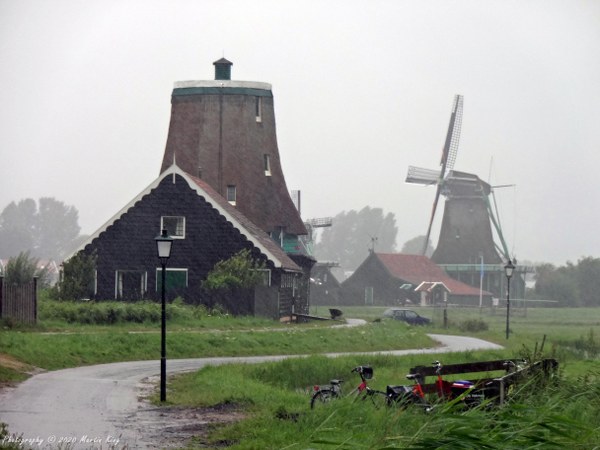 Our cycle path now was a contrast with the cycle highway through the sand dunes, this was a narrow strip of tarmac squeezed between a river and a drainage ditch, but still perfectly fit for purpose. This was real windmill country and after a few kilometres we rode into Zaandijk, a town on the river Zaan and home to Zaanse Schans, one of the country's most famous windmill museum sites. The river was once home to thousands of industrial windmills, only 13 now remain and six of these are here at Zaanse Schans, part of a living museum. This was to be a highlight of our holiday. By the time we arrived here the rain had returned with a vengeance. Waiting to cross a road junction we enjoyed a real comedy moment as I came to a halt at the lights and made that most basic of cycling errors, forgetting to unclip from my pedals. As I picked myself up off the floor the others were having a good giggle at my misfortune. Ah well. Sadly our slower progress meant that by the time we got to Zaanse Schans the windmills had closed, though we could still wander round them and enjoy the spectacle, still in pouring rain.
Our cycle path now was a contrast with the cycle highway through the sand dunes, this was a narrow strip of tarmac squeezed between a river and a drainage ditch, but still perfectly fit for purpose. This was real windmill country and after a few kilometres we rode into Zaandijk, a town on the river Zaan and home to Zaanse Schans, one of the country's most famous windmill museum sites. The river was once home to thousands of industrial windmills, only 13 now remain and six of these are here at Zaanse Schans, part of a living museum. This was to be a highlight of our holiday. By the time we arrived here the rain had returned with a vengeance. Waiting to cross a road junction we enjoyed a real comedy moment as I came to a halt at the lights and made that most basic of cycling errors, forgetting to unclip from my pedals. As I picked myself up off the floor the others were having a good giggle at my misfortune. Ah well. Sadly our slower progress meant that by the time we got to Zaanse Schans the windmills had closed, though we could still wander round them and enjoy the spectacle, still in pouring rain.
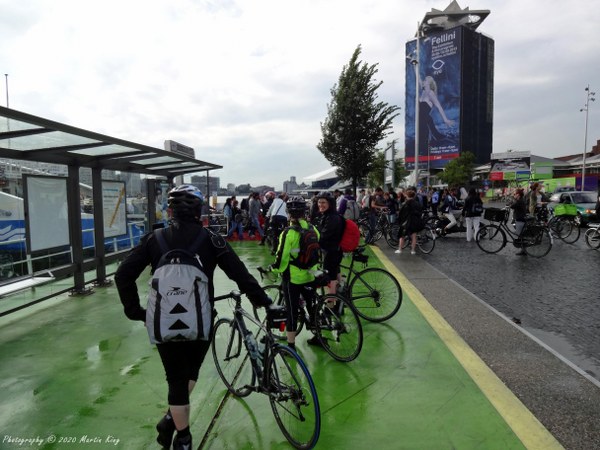 We still had a way to go before we got to Amsterdam and the clock was ticking so we cracked on, riding a mix of cycle paths and small side roads, enjoying another comedy moment as we waited for a herd of cows who were in no hurry to reach the milking parlour (some things are the same the world over). Eventually, and still in rain, we reached the large ferry port on the north side of the Het IJ, a large natural body of water which was once a bay on the North Sea coast, and is now Amsterdam's waterfront. This was a busy place and it was rush hour, commuters were out and about in their hoards. The ferries come thick and fast and we were soon crossing the water and arriving in downtown Amsterdam. By now all we wanted was to find our hotel and get showered and warmed up. Navigation proved to be interesting as we negotiated the network of streets and canals but we soon found our accommodation, a Mercure hotel at the edge of the central quarter. The receptionist greeted me with the alarming news that they had double booked our rooms but he had some good news – they had found us alternative accommodation at their sister hotel, the five star Grand Hotel in the very heart of the city, all at no extra cost. Not only that but they would provide a taxi to whisk us there, locking our bikes away for safekeeping until tomorrow. The taxi driver dropped us at the door of the Grand and we made our way up the carpeted entrance ramp and into the grand foyer, dripping and bedraggled after our day on the bikes, still in our soaked cycling gear. To their great credit the receptionists didn't bat an eyelid and we were soon in our luxurious five-star rooms and before long we all felt human again.
We still had a way to go before we got to Amsterdam and the clock was ticking so we cracked on, riding a mix of cycle paths and small side roads, enjoying another comedy moment as we waited for a herd of cows who were in no hurry to reach the milking parlour (some things are the same the world over). Eventually, and still in rain, we reached the large ferry port on the north side of the Het IJ, a large natural body of water which was once a bay on the North Sea coast, and is now Amsterdam's waterfront. This was a busy place and it was rush hour, commuters were out and about in their hoards. The ferries come thick and fast and we were soon crossing the water and arriving in downtown Amsterdam. By now all we wanted was to find our hotel and get showered and warmed up. Navigation proved to be interesting as we negotiated the network of streets and canals but we soon found our accommodation, a Mercure hotel at the edge of the central quarter. The receptionist greeted me with the alarming news that they had double booked our rooms but he had some good news – they had found us alternative accommodation at their sister hotel, the five star Grand Hotel in the very heart of the city, all at no extra cost. Not only that but they would provide a taxi to whisk us there, locking our bikes away for safekeeping until tomorrow. The taxi driver dropped us at the door of the Grand and we made our way up the carpeted entrance ramp and into the grand foyer, dripping and bedraggled after our day on the bikes, still in our soaked cycling gear. To their great credit the receptionists didn't bat an eyelid and we were soon in our luxurious five-star rooms and before long we all felt human again.
The evening was a relaxed affair after our long day on the bikes. It had all started so well with the sunshine and the tailwind, but by the time we arrived in the Dutch capital we felt battered (though not beaten). We explored the heart of Amsterdam's central quarter and eventually found The Tara, an amazing bar, originally an English pub but now so much more, and settled down to eat and drink our cares away. In amongst all this Pete elicited my help in arranging an appropriate moment, upon which he went down on one knee and proposed to a stunned Sharon. The moment was complete when she said yes and made Pete a very happy man. Helen and I cheered and we all drank to health, happiness and more cycling. What a day!
Day 3: Amsterdam to Loosdrecht (38km, 50m of ascent)
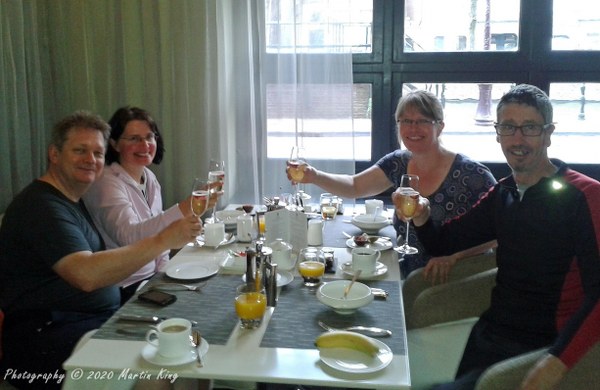 The third day of our tour was planned such that we could spend some time in Amsterdam before continuing with our cycling. From a personal perspective, having never visited the city before, it was an opportunity to get a bit of a feel for the place. First, though, was breakfast and we had all decided that a five-star breakfast would be worth paying a bit extra for. In the event we didn't have too, the hotel staff had got wind of Pete and Sharon's romantic moment the night before and we were offered a full-on champagne breakfast at no cost. Wow! How could we refuse? Needless to say we didn't.
The third day of our tour was planned such that we could spend some time in Amsterdam before continuing with our cycling. From a personal perspective, having never visited the city before, it was an opportunity to get a bit of a feel for the place. First, though, was breakfast and we had all decided that a five-star breakfast would be worth paying a bit extra for. In the event we didn't have too, the hotel staff had got wind of Pete and Sharon's romantic moment the night before and we were offered a full-on champagne breakfast at no cost. Wow! How could we refuse? Needless to say we didn't.
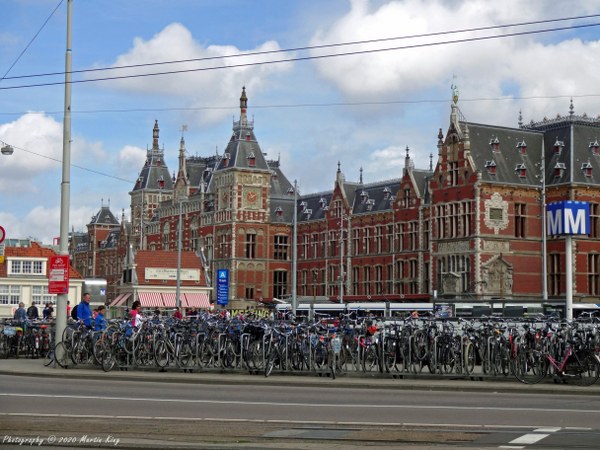 Suitably set up for the day ahead we packed our bags and set out to explore the city. By now the sun was breaking through and it was a day full of promise. Pete and Sharon headed off to to the diamond quarter leaving Helen and I to do our own thing. The canal quarter around the centre of town is a maze of waterways and alleyways and was buzzing. There were bikes everywhere, though for the most part they were parked up, chained to pretty much every railing we could see, and in truth it was far easier to get around on foot. The architectural aspects of any strange city are always fascinating, and here we found much history to absorb with buildings that dated back centuries. We decided much the best way to see Amsterdam was to take a canal boat sightseeing trip so we made our way to the wharves near the station and bought our tickets. The boat trip came with a continuous commentary, in English (of course) and we sat back and enjoyed this floating tourist experience. The next hour and a half flew by as our boat explored seemingly every nook and cranny of the Amsterdam canal system before bringing us back via the Het IJ to our starting point. Helen and I continued our exploration on foot, enjoying the alleyways and plazas, the colour and the architecture before meeting up with Pete and Sharon for a spot of lunch and a cheeky Heineken near the market, taking the opportunity to write a few postcards to send back to the UK.
Suitably set up for the day ahead we packed our bags and set out to explore the city. By now the sun was breaking through and it was a day full of promise. Pete and Sharon headed off to to the diamond quarter leaving Helen and I to do our own thing. The canal quarter around the centre of town is a maze of waterways and alleyways and was buzzing. There were bikes everywhere, though for the most part they were parked up, chained to pretty much every railing we could see, and in truth it was far easier to get around on foot. The architectural aspects of any strange city are always fascinating, and here we found much history to absorb with buildings that dated back centuries. We decided much the best way to see Amsterdam was to take a canal boat sightseeing trip so we made our way to the wharves near the station and bought our tickets. The boat trip came with a continuous commentary, in English (of course) and we sat back and enjoyed this floating tourist experience. The next hour and a half flew by as our boat explored seemingly every nook and cranny of the Amsterdam canal system before bringing us back via the Het IJ to our starting point. Helen and I continued our exploration on foot, enjoying the alleyways and plazas, the colour and the architecture before meeting up with Pete and Sharon for a spot of lunch and a cheeky Heineken near the market, taking the opportunity to write a few postcards to send back to the UK.
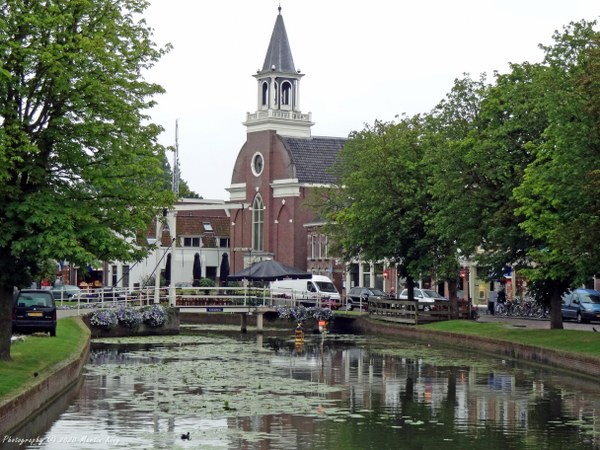 Time now to reunite with our bikes which were still safely locked away. Unfortunately Sharon's bike had somehow acquired a flat which needed repair. I didn't hesitate to offer my puncture-fixing services and before long all was sorted. It was time now to leave Amsterdam and resume our cycle tour, and we headed away from the centre of town to pick up the cycle path which runs along the Amsterdam-Rijnkanaal, a major waterway of some 70 kilometres linking the city docks with the Rhine further south. After some 12km our path took advantage of a major rail crossing and we found ourselves now on the east bank. By now those sunny skies from the morning had been transformed into clouds and we feared the worst as the rain came down, though thankfully it never reached the biblical proportions of yesterday's deluge.
Time now to reunite with our bikes which were still safely locked away. Unfortunately Sharon's bike had somehow acquired a flat which needed repair. I didn't hesitate to offer my puncture-fixing services and before long all was sorted. It was time now to leave Amsterdam and resume our cycle tour, and we headed away from the centre of town to pick up the cycle path which runs along the Amsterdam-Rijnkanaal, a major waterway of some 70 kilometres linking the city docks with the Rhine further south. After some 12km our path took advantage of a major rail crossing and we found ourselves now on the east bank. By now those sunny skies from the morning had been transformed into clouds and we feared the worst as the rain came down, though thankfully it never reached the biblical proportions of yesterday's deluge.
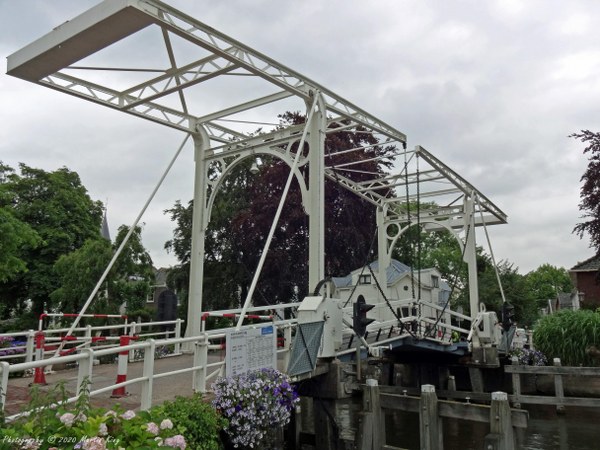 After a few more kilometres alongside the canal we reached Driemond and turned off to detour into the little town of Weesp, a typically pretty Dutch community, quiet after the hustle and bustle of Amsterdam (perhaps the rain had something to do with that). We found a suitable café on the canal, choosing to sit outside under the large umbrellas that sheltered the canalside decking, and tackled a welcome coffee and cake. All too soon it was back to the Rhijnkanaal and on with our journey south to Overmeer, enjoying the windmills and quaint houses which lined our route. Away from the big kanaal our cycle route inevitably followed a smaller water course, the River Vecht, with swing bridges at regular intervals, before we came to the Loosdrechteplassen, a large expanse of water which is really a series of smaller lakes, popular with tourists and which is actually 3 metres below sea level. A road left headed across a narrow dyke which spanned this inland sea to reach the town of Loosdrecht itself where our day's riding came to an end at the gloriously odd Golden Tulip, a modern architecturally bizarre motel which proved to be both comfortable and well appointed and a perfect end to our shortened day.
After a few more kilometres alongside the canal we reached Driemond and turned off to detour into the little town of Weesp, a typically pretty Dutch community, quiet after the hustle and bustle of Amsterdam (perhaps the rain had something to do with that). We found a suitable café on the canal, choosing to sit outside under the large umbrellas that sheltered the canalside decking, and tackled a welcome coffee and cake. All too soon it was back to the Rhijnkanaal and on with our journey south to Overmeer, enjoying the windmills and quaint houses which lined our route. Away from the big kanaal our cycle route inevitably followed a smaller water course, the River Vecht, with swing bridges at regular intervals, before we came to the Loosdrechteplassen, a large expanse of water which is really a series of smaller lakes, popular with tourists and which is actually 3 metres below sea level. A road left headed across a narrow dyke which spanned this inland sea to reach the town of Loosdrecht itself where our day's riding came to an end at the gloriously odd Golden Tulip, a modern architecturally bizarre motel which proved to be both comfortable and well appointed and a perfect end to our shortened day.
Day 4: Loosdrecht to Gouda (80km, 80m of ascent)
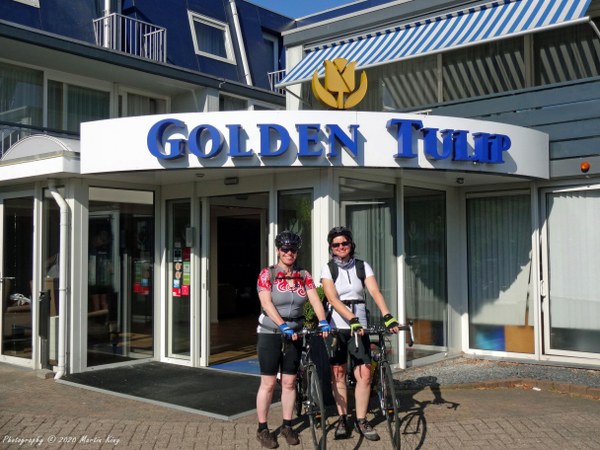 Sunny blue skies greeted us as we threw back the curtains and stepped out on to the roof from where we could look across the town rooftops. A hearty breakfast and we were soon on our way on the fourth day of our tour, this being a longer day but with precious little in the way of climbing so, on the face of it, not overly demanding. Our first task was to retrace our route across the dyke and back onto the main route following the Vecht River south. As we came to the river outlet from the Loosdrechteplassen a large launch caused the road (and our cyclepath) to be raised, so we watched with interest. It's amazing what mundane sights can acquire an aura of excitement sometimes.
Sunny blue skies greeted us as we threw back the curtains and stepped out on to the roof from where we could look across the town rooftops. A hearty breakfast and we were soon on our way on the fourth day of our tour, this being a longer day but with precious little in the way of climbing so, on the face of it, not overly demanding. Our first task was to retrace our route across the dyke and back onto the main route following the Vecht River south. As we came to the river outlet from the Loosdrechteplassen a large launch caused the road (and our cyclepath) to be raised, so we watched with interest. It's amazing what mundane sights can acquire an aura of excitement sometimes.
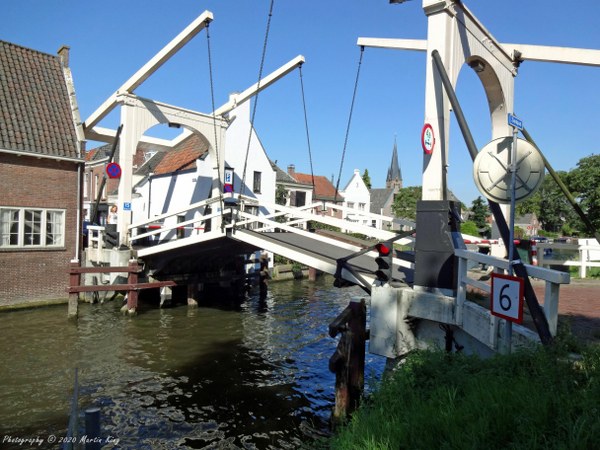 After just a few kilometres we came to Breukelen, and its bridge, said to be the original Brooklyn Bridge for which New York is renowned. The town is functional and utilitarian and by far and away the most scenic bit is the bridge itself! We were fortunate in our timing as a number of boats chose this moment to pass and the bridge was opened to allow them passage. It was an exciting moment.
After just a few kilometres we came to Breukelen, and its bridge, said to be the original Brooklyn Bridge for which New York is renowned. The town is functional and utilitarian and by far and away the most scenic bit is the bridge itself! We were fortunate in our timing as a number of boats chose this moment to pass and the bridge was opened to allow them passage. It was an exciting moment.
Along the river bank there were numerous well appointed residences, some quite splendid in their style with turrets, arches and columns, summerhouses and ornate gardens as well as their own personal landing platforms. We tried to imagine who would be living here – and how much such houses might cost. Not that we were in the market, you understand, just interested! The next town was Maarssen which is really the start of the Utrecht sprawl and marked a transition from gentle country river path to a more industrialised path as we homed in on the centre of Utrecht itself.
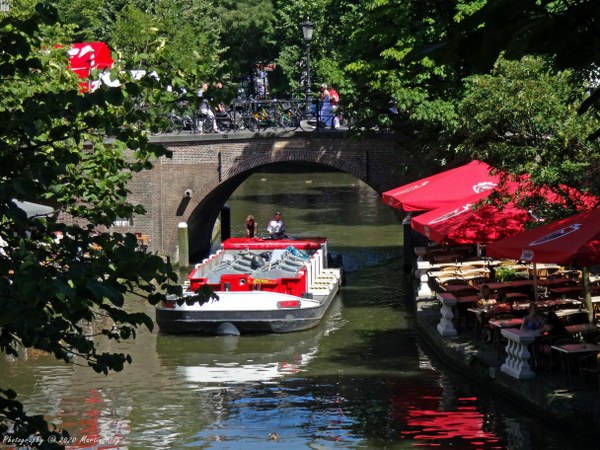 Utrecht proved to be a place of much intrigue, history and interest, worthy of some exploration. But first we needed a break and we found solace seated outside in the morning sunshine on canalside tables at the Restaurant Oudaen where we ordered a cheeky beer and sat and watched the waterworld go by. With the trees lining the canal and the streets, the pretty coloured and varied style buildings and the hustle and bustle it was a compulsive place to pause and enjoy. The city is the fourth largest in the Netherlands, an important part of the Dutch Golden Age of commerce, and is dominated by the Dom Tower, the huge cathedral tower in the centre of the city, dating back to the 14th century. Standing over 112 metres high, it dominates the view from pretty much everywhere in the centre and even has a road through the middle of it which, of course, we had to ride through.
Utrecht proved to be a place of much intrigue, history and interest, worthy of some exploration. But first we needed a break and we found solace seated outside in the morning sunshine on canalside tables at the Restaurant Oudaen where we ordered a cheeky beer and sat and watched the waterworld go by. With the trees lining the canal and the streets, the pretty coloured and varied style buildings and the hustle and bustle it was a compulsive place to pause and enjoy. The city is the fourth largest in the Netherlands, an important part of the Dutch Golden Age of commerce, and is dominated by the Dom Tower, the huge cathedral tower in the centre of the city, dating back to the 14th century. Standing over 112 metres high, it dominates the view from pretty much everywhere in the centre and even has a road through the middle of it which, of course, we had to ride through.
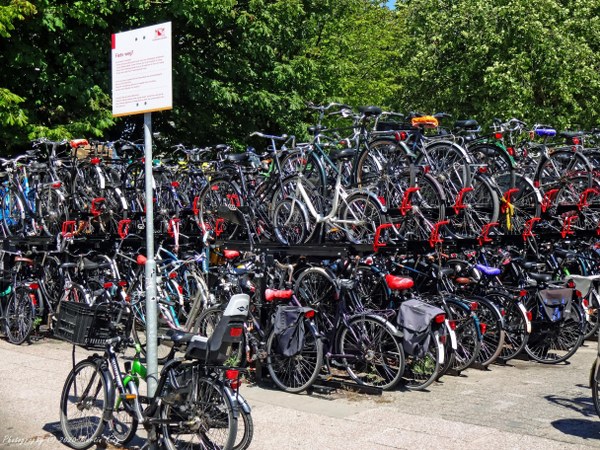 As we headed out of the city we passed the railway station and were stunned by the enormity of the bicycle park there. Here there were machines in their hundreds, two layers deep and it was absolutely full. There were even bikes tethered to signposts and lampposts. Goodness knows how you ever remember where you left your bike when you come to collect it. We tried hard to imagine such a scene back in the UK and decided that we couldn't.
As we headed out of the city we passed the railway station and were stunned by the enormity of the bicycle park there. Here there were machines in their hundreds, two layers deep and it was absolutely full. There were even bikes tethered to signposts and lampposts. Goodness knows how you ever remember where you left your bike when you come to collect it. We tried hard to imagine such a scene back in the UK and decided that we couldn't.
For me, leaving Utrecht was probably the messiest part of our entire trip, as we followed a major arterial road before heading off along a canal and then over a busy road bridge across the Amsterdam-Rijnkanaal for the last time (fortunately on a separate two-way cycle path), and passing the Douwe Egberts coffee manufacturing plant. This was 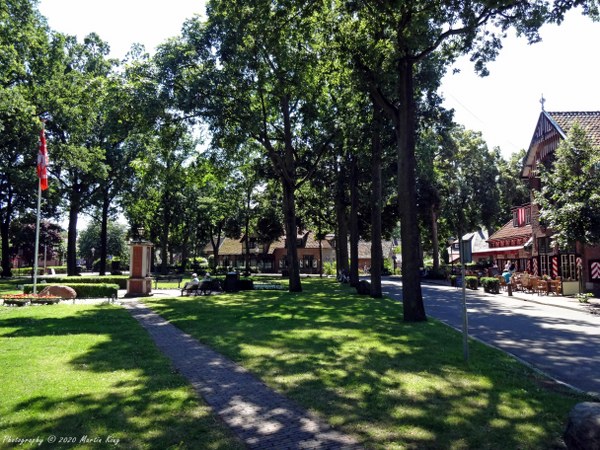 industrial Utrecht and despite the well marked cycle paths we managed to get lost along here before finally getting away from another main road into more provincial parts. The next village was the splendidly picturesque Haarzuilens, which struck me as similar in many ways to Eccleston on the outskirts of Chester for those who know it. It is closely tied with the nearby De Haar castle and all the buildings in the village, which surrounds a large village green, have window shutters which bear the red and white of the castle shield. A welcoming pub situated on the corner of the green was inviting and our clocks told us that lunch was overdue so we parked up and enjoyed a long (probably overlong) lunch stop, enjoying the afternoon sunshine and the surroundings. Cycle touring holidays are made for moments such as these.
industrial Utrecht and despite the well marked cycle paths we managed to get lost along here before finally getting away from another main road into more provincial parts. The next village was the splendidly picturesque Haarzuilens, which struck me as similar in many ways to Eccleston on the outskirts of Chester for those who know it. It is closely tied with the nearby De Haar castle and all the buildings in the village, which surrounds a large village green, have window shutters which bear the red and white of the castle shield. A welcoming pub situated on the corner of the green was inviting and our clocks told us that lunch was overdue so we parked up and enjoyed a long (probably overlong) lunch stop, enjoying the afternoon sunshine and the surroundings. Cycle touring holidays are made for moments such as these.
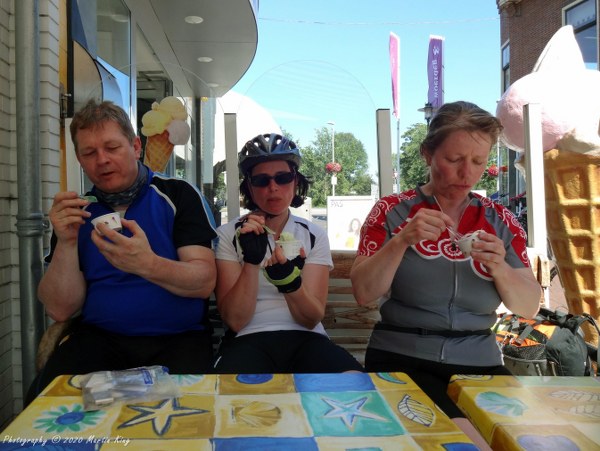 Once we got under way again we soon came upon the castle, just on the outskirts of the village, and it really was a splendid sight. It has a long and chequered history, dating back to 1391, with 200 rooms and (amazingly) 30 bathrooms! The castle entrance is commanding and we stopped for a few photos, posing at the splendid gates, before continuing on our way. We were back on small roads and cycle paths crossing low lying farmland, much more enjoyable after the hectic sprawl of Utrecht, before we reached Woerden, a commuter town for Amsterdam, Rotterdam and Utrecht. The town has a long history of cheese making and is renowned for its cheese market, dating back to 1885. Detouring into the centre we looked for somewhere to take a break as the afternoon was slipping away. We found an ice-cream parlour and, as we were on holiday and every holiday should feature at least one ice-cream break, decided this was the moment.
Once we got under way again we soon came upon the castle, just on the outskirts of the village, and it really was a splendid sight. It has a long and chequered history, dating back to 1391, with 200 rooms and (amazingly) 30 bathrooms! The castle entrance is commanding and we stopped for a few photos, posing at the splendid gates, before continuing on our way. We were back on small roads and cycle paths crossing low lying farmland, much more enjoyable after the hectic sprawl of Utrecht, before we reached Woerden, a commuter town for Amsterdam, Rotterdam and Utrecht. The town has a long history of cheese making and is renowned for its cheese market, dating back to 1885. Detouring into the centre we looked for somewhere to take a break as the afternoon was slipping away. We found an ice-cream parlour and, as we were on holiday and every holiday should feature at least one ice-cream break, decided this was the moment.
The last stretch of our day's riding was across flat farming country between Woerden and Gouda, following a meandering cycle path through villages such as Lange Linschoten, Oudewater, Hekendorp and Haastrecht before finally reaching our destination. Our accommodation was a Campanile Hotel in an industrial estate on the edge of town, not the most romantic finish to our day, but welcoming, comfortable and well appointed. Exploring the town of Gouda would wait until tomorrow, right now we very much wanted to sit down with a cheeky beer, peruse the menu and reflect on another splendid day on the bikes.
Day 5: Gouda to Europoort (93km, 120m of ascent)
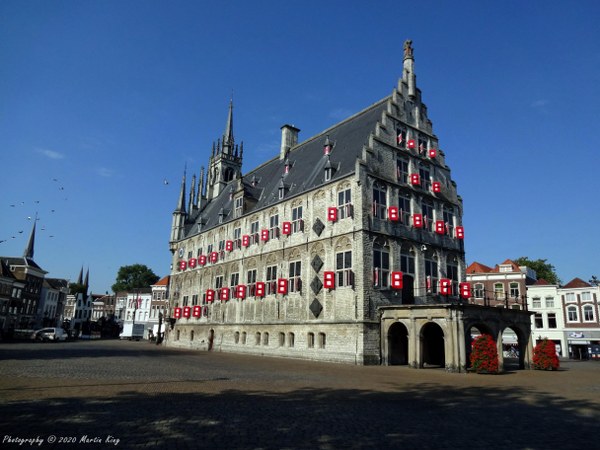 Our last day dawned yet again clear, sunny and warm. A fitting end to our trip, but we had ahead of us our longest day with a ferry to catch at the end of it. In hindsight it might have been wiser to make this a shorter day, but that is the great thing about hindsight. We were soon breakfasted and ready to roll and our first target was to ride into town and have a (brief) look round. Gouda is renowned for its cheese and is surrounded by a number of working cheese farms. There seemed little evidence of its cheesy heritage in the town centre apart from a few farmshop outlets, but it did have an imposing market square surrounded by the usual plethora of colourful buildings and with a wonderful town hall at its centre. The incongruity of a wonderful period building front housing a Subway food outlet seemed to sum up the integration of the old and the new.
Our last day dawned yet again clear, sunny and warm. A fitting end to our trip, but we had ahead of us our longest day with a ferry to catch at the end of it. In hindsight it might have been wiser to make this a shorter day, but that is the great thing about hindsight. We were soon breakfasted and ready to roll and our first target was to ride into town and have a (brief) look round. Gouda is renowned for its cheese and is surrounded by a number of working cheese farms. There seemed little evidence of its cheesy heritage in the town centre apart from a few farmshop outlets, but it did have an imposing market square surrounded by the usual plethora of colourful buildings and with a wonderful town hall at its centre. The incongruity of a wonderful period building front housing a Subway food outlet seemed to sum up the integration of the old and the new.
Time to press on. We headed out of Gouda, following the Hollandse Ijssel river towards Moordrecht for our first river crossing of the day, a small ferry across the river from Gouderak. At a push it might have accommodated two vehicles, but there was plenty of room for the four of us with bikes and a mum with pushchair. We alighted and rode 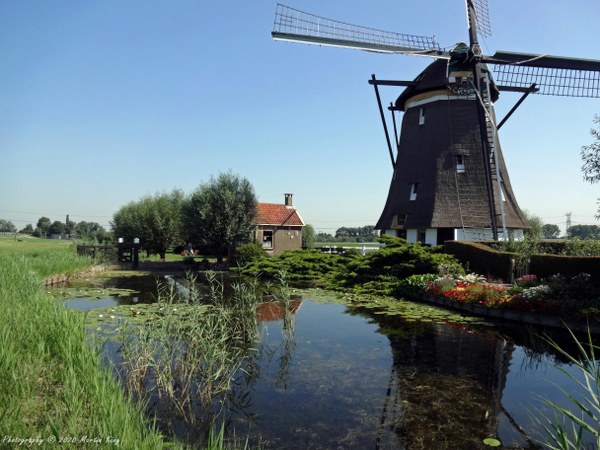 straight through Moordrecht and out into the farmland, along a cobbled section of cycle path alongside the A20 motorway. We were now officially in the Lowlands of Holland, significantly some 7 metres below sea level. It was a sobering thought that all that kept us from drowning was a network of dykes, canals and windmills. The Dutch have certainly got their sea defences well organised. We turned away from the motorway and headed out across vast fields, windmills dotted along the horizon. We passed through the village of Zevenhuizen, a pleasant enough little commune but with no obvious sign of coffee shops sadly. Shortly after this we made an abrupt turn and now headed south alongside the Rotte river, with a series of windmills lined along its banks. These windmills are fully functioning (unlike some we have passed) and crucial for the irrigation and drainage round here. It is quite a sight and made up for our disappointment at Zaanse Schans on day 2. The windmills are old too, one had a board above the sails indicating that it dated back to 1792. Food for thought. Talking of refreshment we now came across Meerenbos, a lovely restaurant on the river bank and stopped for a welcome coffee break, in full view of the windmills. It was a lovely setting and the morning sun added to a feeling of contentment.
straight through Moordrecht and out into the farmland, along a cobbled section of cycle path alongside the A20 motorway. We were now officially in the Lowlands of Holland, significantly some 7 metres below sea level. It was a sobering thought that all that kept us from drowning was a network of dykes, canals and windmills. The Dutch have certainly got their sea defences well organised. We turned away from the motorway and headed out across vast fields, windmills dotted along the horizon. We passed through the village of Zevenhuizen, a pleasant enough little commune but with no obvious sign of coffee shops sadly. Shortly after this we made an abrupt turn and now headed south alongside the Rotte river, with a series of windmills lined along its banks. These windmills are fully functioning (unlike some we have passed) and crucial for the irrigation and drainage round here. It is quite a sight and made up for our disappointment at Zaanse Schans on day 2. The windmills are old too, one had a board above the sails indicating that it dated back to 1792. Food for thought. Talking of refreshment we now came across Meerenbos, a lovely restaurant on the river bank and stopped for a welcome coffee break, in full view of the windmills. It was a lovely setting and the morning sun added to a feeling of contentment.
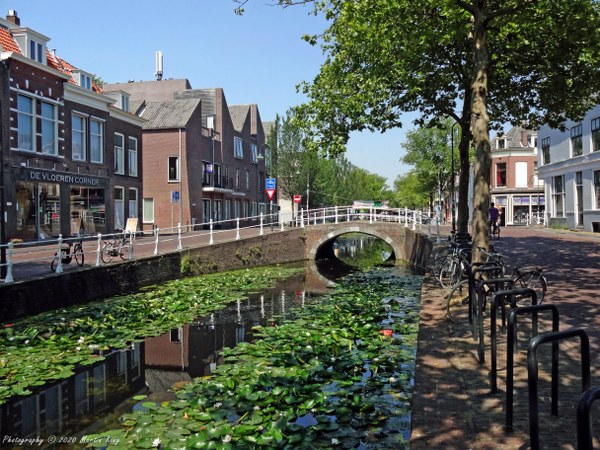 Still the clock was ticking, so we had to keep going. A mix of well graded cycle path and road had spoiled us somewhat and shortly before Delft our route deteriorated dramatically as we were directed on what can only be described as an off road route, on a narrow single track muddy path alongside the river, fine just as long as no-one was coming the other way! Eventually, some 45 kilometres into our day, we rode into the city of Delft, renowned for its pottery and medieval canals. We rode alongside one canal which was full of water lilies, a captivating sight. The centre of Delft is mainly traffic free and has a number of squares and plaza, one of which proved an ideal candidate for lunch as we spied an open air restaurant shaded by a number of trees. Perfect. A cheeky beer and a wonderful salad washed down with a coffee matched our mood and we relaxed.
Still the clock was ticking, so we had to keep going. A mix of well graded cycle path and road had spoiled us somewhat and shortly before Delft our route deteriorated dramatically as we were directed on what can only be described as an off road route, on a narrow single track muddy path alongside the river, fine just as long as no-one was coming the other way! Eventually, some 45 kilometres into our day, we rode into the city of Delft, renowned for its pottery and medieval canals. We rode alongside one canal which was full of water lilies, a captivating sight. The centre of Delft is mainly traffic free and has a number of squares and plaza, one of which proved an ideal candidate for lunch as we spied an open air restaurant shaded by a number of trees. Perfect. A cheeky beer and a wonderful salad washed down with a coffee matched our mood and we relaxed.
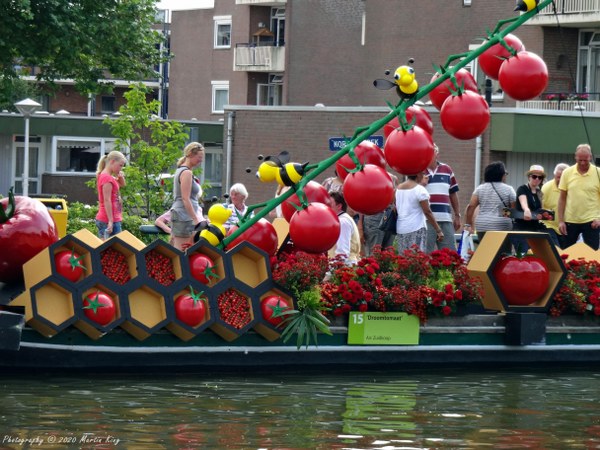 We were brought back down to earth when, as we got up to continue on our way we found that Sharon's bike now had a puncture. Leaving Pete to see what he had learned after my master-class two days previously, Helen and I took the opportunity to explore Delft's city centre and take in the sights. Bizarrely, cheese was much more on show here, whilst in the main square a stage was being erected for an evening concert in front of the magnificent town hall building. We rejoined Pete and Sharon to find Pete still grappling with Sharon's tyres but soon we were on the road again, heading out of Delft along a canal and into the village of Schipluiden where their annual colourful musical boat fest was in full flow, with dozens of moored barges along the river bank, bedecked with fruit, flowers and vegetables. There were several barges heading along the river with music blaring and dancers cavorting on the decks. It was quite a picture and we stopped to enjoy it for a while.
We were brought back down to earth when, as we got up to continue on our way we found that Sharon's bike now had a puncture. Leaving Pete to see what he had learned after my master-class two days previously, Helen and I took the opportunity to explore Delft's city centre and take in the sights. Bizarrely, cheese was much more on show here, whilst in the main square a stage was being erected for an evening concert in front of the magnificent town hall building. We rejoined Pete and Sharon to find Pete still grappling with Sharon's tyres but soon we were on the road again, heading out of Delft along a canal and into the village of Schipluiden where their annual colourful musical boat fest was in full flow, with dozens of moored barges along the river bank, bedecked with fruit, flowers and vegetables. There were several barges heading along the river with music blaring and dancers cavorting on the decks. It was quite a picture and we stopped to enjoy it for a while.
From Schipluiden we continued through yet more fields, passing large greenhouses, and in a short while rode into Hoek van Holland, our circular journey now complete. After all our anxiety about the day's timetable we had made it in plenty of time and even had some time to wait for our ferry. It was an opportunity to enjoy one last ice cream and a cold drink while we waited in the afternoon sunshine. The fast ferry whisked us back across the Nieuwe Waterweg to Maasvlakte, dodging the massive ocean-going barges. We now had the 20 kilometre return journey, back to the P+O Ferry dock, retracing our route from five days earlier. Signs for “Engeland” suggested we were on the right path and before long our ferry came into view, a vast city on water where they were already boarding for the evening sailing. We rode up the boarding ramp, parked our bikes and made our way to the lounge, sat back to reflect on our adventures with the help of a cheeky beer. Another long day, but we were still smiling and buzzing with what we had enjoyed over the last few days.
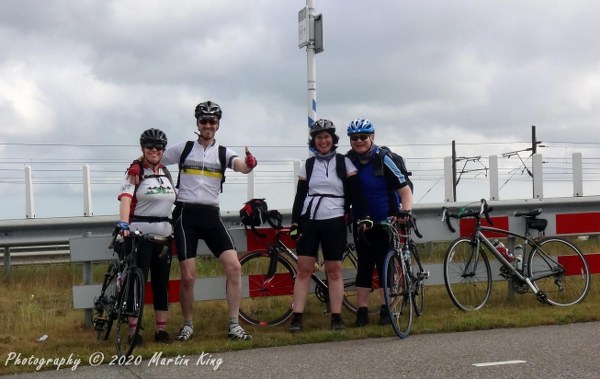
Postscript
As a footnote, it was a salutary moment when the next morning, after we disembarked in Hull and rode back to find our vehicle, we were greeted by a hostile local at a roundabout not far from the ferry terminal whose advice was that we should get off the road and out of his way. Welcome back! It seemed to sum up in a trice a major difference between cycling in the UK and in the Netherlands. Over there bicycles and cyclists are respected and are in such common use that after a while you hardly notice. Back in the UK we were rudely reacquainted with a hierarchy which puts cars and other motor vehicles firmly on top of a self-appointed pile with sadly little regard for more vulnerable road users. The recent resurgence in cycling here in the UK may help to shift this balance a little and maybe, just maybe, we can all enjoy our traffic network as equals. Riding through the Netherlands had truly been a delightful experience. People were courteous and helpful, everyone seemed to speak English, route finding was (generally) easy, the history, architecture and culture were fascinating, the beer and coffee excellent. The one thing I yearned for as we returned to the UK was a decent hill climb, something I put to rights on my first ride back on these shores! I for one would love to go back and ride some more of Holland's cycleways.